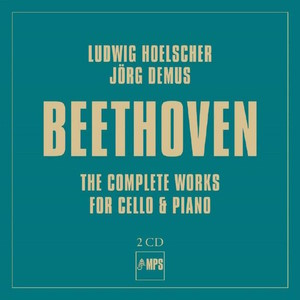
Ludwig van Beethoven (1770-1827)
Cello Sonata in F major, Op. 5 No. 1 (1796)
Cello Sonata in G minor, Op. 5 No. 2 (1796)
Cello Sonata in A major, Op. 69 (1808)
Cello Sonata in C major, Op. 102 No. 1 (1815)
Cello Sonata in D major, Op. 102 No. 2 (1815)
Variations in G major on See the conqu’ring hero comes from Handel’s Judas Maccabaeus WoO45 (1796)
Variations in F major on Ein Mädchen oder Weibchen from Mozart’s Die Zauberflöte Op. 66 (1798)
Variations in E flat major on Bei Männern, welche Liebe fühlen from Mozart’s Die Zauberflöte WoO46 (1801)
Ludwig Hoelscher (cello)
Jörg Demus (piano)
rec. May 1972, MPS Studio
MPS Records 0302923BC [66 + 66]
Fifteen years after he and Elly Ney recorded their cycle of Beethoven’s cello works, Ludwig Hoelscher returned to the same repertoire with Jörg Demus. The 1957 Ney recordings have been reissued by Forgotten Records (review) but they sound dull – both sonically and interpretatively – in comparison with the later recordings, which were made in the MPS Studio in 1972 for Edel (MPS is one of Edel’s labels). Even though the cellist was now in his mid-60s, and his tone had lost something of its depth and lustre – had in fact become rather dryer – the combination of Hoelscher with Demus seems to have rejuvenated the older man. Whereas, though a part of Ney’s chamber ensembles since the 1930s, he was very much the subservient partner to her, the partnership with Demus seems to have been one of equals.
In every movement where it most matters, Hoelscher and Demus are quicker, and more rhythmically resilient and the amplitude of the recorded sound reinforces these positive virtues. Ney’s extended opening movement and Allegro of the Sonata in F major is replaced here by something altogether more athletic and vital. Hoelscher’s tonal profile is much clearer than in the old Telefunkens, and his phrasing – much crisper too – responds to Demus’s sensitive but ‘get on with it’ pianism. Their affinity significantly adjusts the earlier approach to Op.69 – probably the most radical Hoelscher rethink in the set – leading to far more vivacity and commitment.
The two approaches are almost as explicit in Op.102 No.1 where Ney’s reverential phrasing in its opening Andante contrasts markedly with Demus’s clarity and virility. His newer aesthetic galvanizes Hoelscher to playing that’s altogether more fluid and lighter on its feet, and less freighted with ideas of significance. Occasionally, Hoelscher’s technique comes under some scrutiny. There are a few awkward phrasal and digital moments in Op.102 No.2 and it would be idle to suggest that he had maintained all his earlier strengths but compensation comes from the enhanced rapport with Demus, and the maintenance of Hoelscher’s intensity of phrasing.
The three sets of variations are splendidly realised and characterised and reflect their outward-looking character. The sonatas, as noted, are more extrovert too whilst not in any way overlooking their introspective moments – just ensuring that they don’t predominate. These recordings were released in 1974, the same year Hoelscher left his teaching commitments in Stuttgart, and are available in digital form for the first time. The gatefold arrangement for the two discs works well and the remastered sound is really splendid.
Jonathan Woolf
Help us financially by purchasing from




















